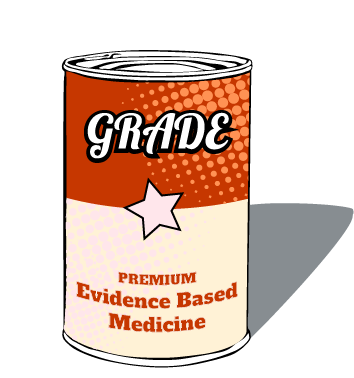The GRADE approach lays out a detailed stepwise process that defines what role the quality of the available evidence plays in the development of health care recommendations. The merit of GRADE is not that it eliminates judgments or disagreements about evidence and recommendations, but rather that it makes them transparent. Transparency in recommendations and further on in policy-making adds to their ultimate credibility.
We believe the GRADE approach could be adapted to many branches of science. For now, it is widely used in health care and is a major achievement in evidence-based medicine.
We believe the GRADE approach could be adapted to many branches of science. For now, it is widely used in health care and is a major achievement in evidence-based medicine.

GRADE approach
Fundamentally the GRADE approach is based on the philosophy of evidence based health care decision making, and involves the integration of three domains:
- 1. First, it considers the state of health and other circumstances such as where the decision making takes place. Are we dealing with a low income country, a high income country, a primary or tertiary care hospital? What are the circumstances and the health state that the individual patient presents with?
- 2. In the second domain, the patient’s, populations’ and societal values and preferences affect the importance of certain outcomes for decision making.
- 3. In the third domain, the actual underlying research evidence is carefully evaluated.

Merits of the GRADE system for grading the quality of evidence and strength of recommendations in comparison to other systems:
- Clear separation between quality of evidence and strength of recommendations
- Explicit and comprehensive criteria for downgrading or upgrading quality of evidence
- Explicit consideration of the relative importance of various outcomes to patients
- Explicit acknowledgement of values and preferences when making recommendations
- Transparent process of moving from evidence to recommendations
- Explicit advice to make recommendations about the most appropriate course of action, even when very little evidence is available
- Grading the strength only for recommendations about the diagnostic or therapeutic course of action, but not about prognosis or etiology
- Clear and pragmatic interpretation of ‘strong’ and ‘weak’ recommendations
- Balance between simplicity and methodological comprehensiveness
GRADE resources
Articles about the GRADE approach
GRADE tools
GIN-McMaster Guideline Development Checklist
This list presents and explains the steps that every researcher and guideline developer should complete in order to achieve the optimal = the most transparent, reliable and practical guidelines.visit the websiteGRADEpro
GRADEpro is software that supports creating summary tables for systematic reviews and health technology assessments, and facilitates the development of clinical practice guidelines, as well as other documents making recommendations for public health or health policy decisions. It also provides a database of GRADE evidence tables and health care recommendations for adoption, adaptation and development of new guidelines.GRADEpro was partially developed through the GRADE Working Group‘s DECIDE project. The GRADE Working Group, the Cochrane Collaboration, and members of McMaster University ensure that up‐to‐date methods are incorporated into GRADEpro and help to develop new functionalities.visit the website